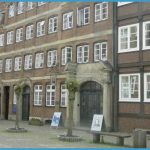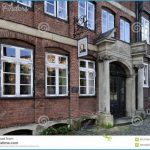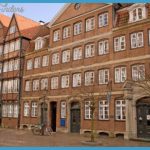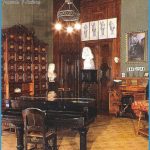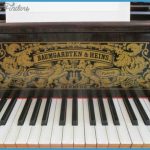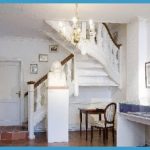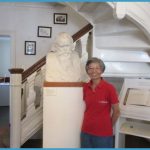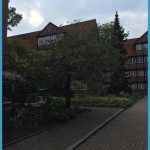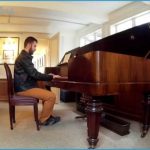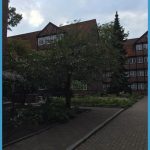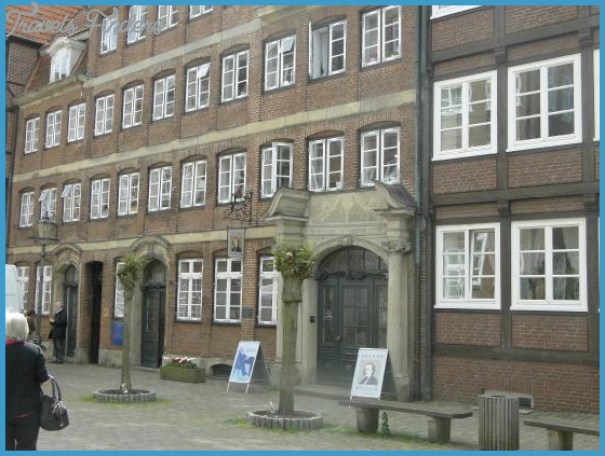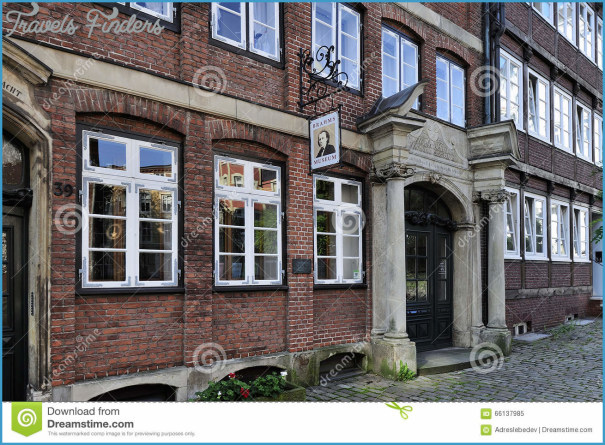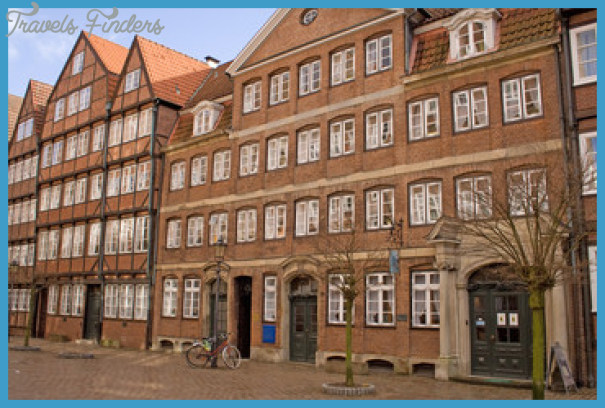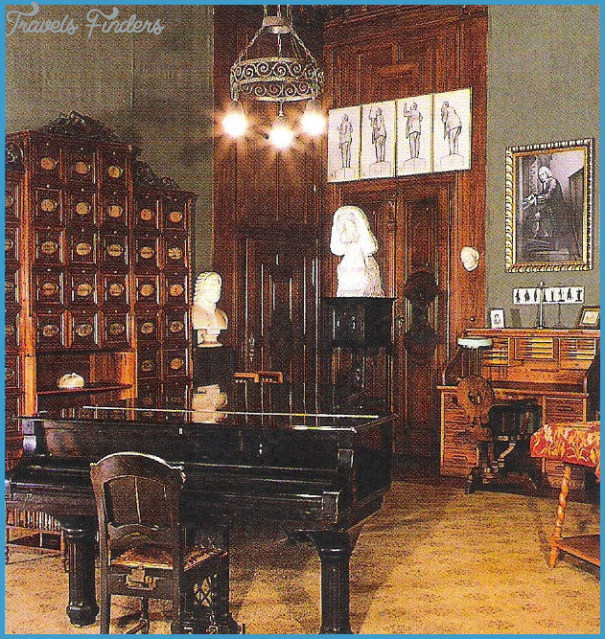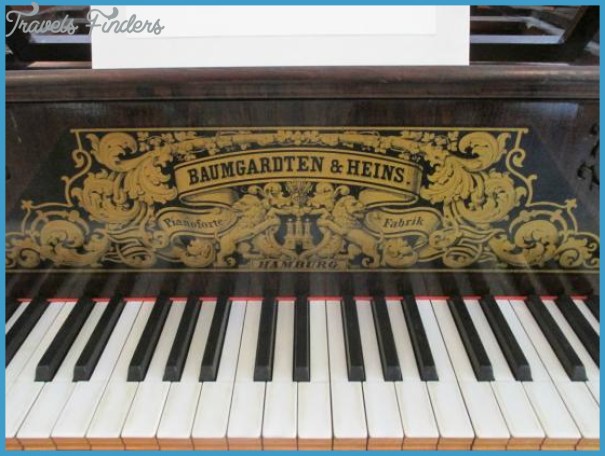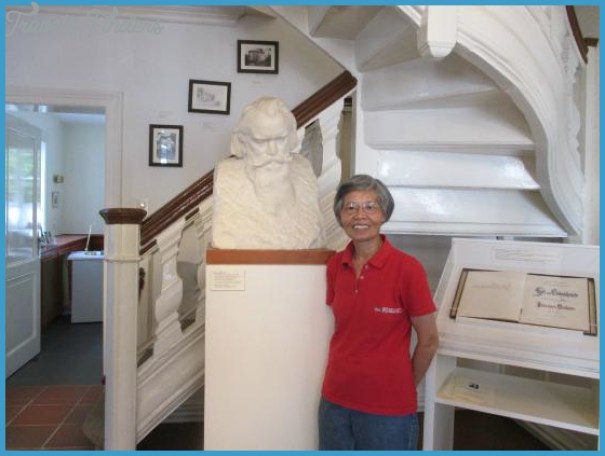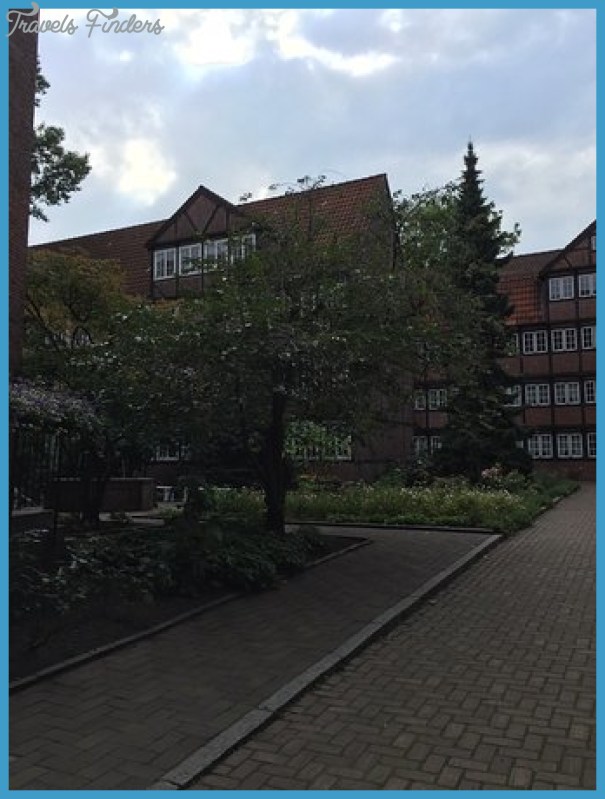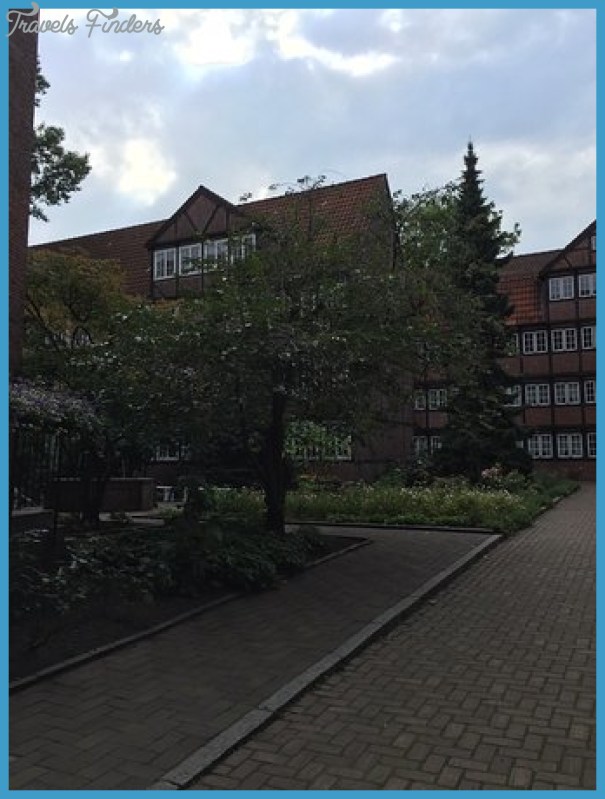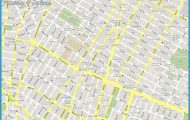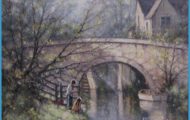BRAHMS MUSEUM
A whistle-stop tour is very much in the spirit of Johannes Brahms’s life. He was a great traveller, mainly in Germany, Switzerland and Austria, but also to Italy and eastern Europe, nearly always in the cause of music or, if not, in the persuit of friendship. Travelling forms the main theme of the imaginatively conceived Brahms museum at Murzzuschlag, in Styria, where he spent two apparently idyllic summers. Some of the places with which he is associated, like Portschach in Carinthia and Altaussee in north Styria, he discovered while on tour or on holiday. Others, like Baden-Baden in the Black Forest, Rudesheim on the Rhine and Gmunden on the Traunsee, he visited at the invitation of friends and then happily returned to. From the evidence of the surviving buildings and furnishings, contemporary accounts and photographs we know that, wherever he was, Brahms lived simply and without personal vanity.
He harboured mixed feelings about his native Hamburg. The family was not impoverished, but was never very well off. They lived first in the Schluterhof at Specksgang 24, where he was born on 7 May 1833, and moved to larger flats in 1835 and 1851. His parents provided their son with an excellent education, even if in his teens he played the piano in bars and dance halls to earn money. From 1853 he was often away from Hamburg, although it remained his base until 1862 when he decided Vienna would better suit his purpose. While several times invited to conduct and perform with the Hamburg Philharmonic, his hopes of a permanent post with the orchestra were never realized.
Johannes Brahms Museums Photo Gallery
Any lingering disappointment was finally put aside when, in 1889, the title of Honorary Citizen of Hamburg was conferred on him. Further marks of favour followed. But perhaps it was too late when all the ships in the Hamburg harbour flew black flags and lowered their ensigns to half-mast at the hour of his funeral in Vienna on 6 April 1897. In 1906 a plaque was erected on his birthplace; when the building was destroyed by bombing in 1943 the plaque was salvaged and later attached to a freestanding memorial stone placed nearby in 1958. Another plaque commemorates the building close to its original site.
Rights were not granted to include these illustrations in electronic media. Please refer to print publication Plaque near the site of the Brahms birthplace front of the hall, in Karl-Muck-Platz. Nearby, in the entrance of the Kleine Musikhalle, is a ‘Relief-Buste by Walter Zehle. In 1983 a plaque in memory of his baptism was erected in the St Michaelis-Kirche.
In 1969, a Johannes Brahms-Gesellschaft Internationale Vereinigung was founded to establish a Brahms memorial room and archive in Hamburg at PeterstraSe 39, where the society now has its offices and two first-floor rooms are open to the public. The displays are drawn from the distinguished Hofmann Collection, the largest privately held Brahms archive. These include surviving items from Brahms’s childhood: his baptism spoon, silver tumbler and confirmation cup; a photograph of his first music teacher; a copy of his C major
Piano Sonata op.1 ; a copy of the 14 November 1855 concert programme in which Brahms appeared with Clara Schumann and Joseph Joachim; and facsimiles of other works associated with his time in Hamburg such as the op.24 Variations and Fugue on a Theme by Handel, dedicated to Clara in 1861. The document relating to his honorary citizenship is reproduced along with a death mask.
Brahms’s meeting with Robert and Clara Schumann in 1853, when he was 20, altered the course of his life: where he lived, how he lived, what he composed. Schumann’s mentorship was sadly brief as only months later he suffered a nervous breakdown, followed by confinement and in 1856 death. But from the time of Schumann’s incapacitation Brahms seems to have dedicated himself to Clara, 14 years his senior, and her children. Their friendship, which was lifelong, involved their spending several summers in close proximity in Lichtental, on the edge of Baden-Baden, a spa town that attracted other musicians, including Johann Strauss, Hermann Levi and Pauline Viardot-Garda.
During the summers between 1862 and 1873 Clara moved her family and two grand pianos to a house in Lichtental that backed on to the River Oos and the oak-tree promenade known as the Lichtentaler Allee; the house, at HauptstraSe 8, still stands and is marked by a commemorative plaque. Brahms first went to Baden-Baden in 1863, staying with a surgeon, Dr Hammer. He returned in 1864, this time staying briefly with Anton Rubinstein and then at the Hotel zum Baren, where he completed the Piano Quintet in F minor op.
The following summer he rented two rooms in a hilltop house, built in 1790, overlooking the Kloster Lichtental not far from Clara’s house. The address was Lichtental 136, later HauptstraSe 138 and today MaximilianstraSe 85. His ‘hubsche Haus auf dem Hugel was – and still is – reached by steep steps. His regime involved rising early and taking a long walk in the woods, then working until 5 p.m. visiting Clara, returning to work and then rejoining Clara for dinner and piano duets. Brahms returned every summer until 1873, when he stayed only a few days; he visited there again in 1876 and 1877. In 1883 he gave a birthday party for Clara at the Hotel zum Baren on 13 September and in 1887 joined her and their friends, the cellist Robert Hausmann and the violinist Joseph Joachim, to play through the Double Concerto op.102, which they performed for an invited audience at the Kurzhaus in Baden-Baden on 23 September. Shortly before Clara’s death, in 1896, Brahms wrote to her about meeting again in Lichtental.
Lichtental proved to be a place where Brahms was able to compose: here he completed the Deutsches Requiem and the first two symphonies. Besides the Piano Quintet he produced the String Sextet op.36, the Horn Trio op.40 and the E minor Cello Sonata op.38. Closely associated with Clara and her family are his four-hand piano arrangement of Schubert’s Mass in E flat and the Alto Rhapsody op.53, which he wrote in 1869 as a wedding present for Julie Schumann. The Liebeslieder-Walzer op.52 and the Lieder und Gesange op.58 also date from his time at Lichtental.
The top-floor rooms in which he lived and worked have been open to the public since 1968, after being saved from demolition. The restored Blue Parlour once had a piano but now is decorated with period furniture, portraits and a
Brahms’s summer retreat at Lichtental bust. The small dormer bedroom is also furnished, with a bust of Clara Schumann by Friedrich Christoph Haussmann and photographs. A third room is incorporated as a display room, with a chronology of Brahms’s time in Baden-Baden and a photo collage relating to his life in Vienna, Clara Schumann, his death and memorials. Among the items on display are a statuette by Carl Kundmann and a death mask, a ring made from Mendelssohn’s hair, poetry and an album of Brahms’s music owned by Julie Schumann, and an autograph letter from Clara. Downstairs, once a coffee house, is a studio fitted out as a flat which the Brahmsgesellschaft Baden-Baden makes available to visiting musicians, composers and musicologists. Baden-Baden honours the composer every other year with a series of Brahmstage, and two town squares are named after Brahms and Clara Schumann.
Brahms first visited Altaussee, the Styrian resort that still serves as an embarkation point for walking tours of the Austrian Alps, when he was on holiday with his father in 1862. They stayed two days so that Brahms might have his shoes repaired. He is said by locals to have returned 13 years later, to join Clara Schumann when she was renting a lakeside house. He certainly returned in 1882 for a performance of his Piano Trio in C op.87 and the String Quintet in F op.88. The concert is commemorated with a plaque on the side of the Hotel Seevilla, which also remembers him with a Brahms Cafe.
Brahms discovered the delights of Portschach, a luxurious spa perched on a peninsula on the northern side of the Worthersee, when performing at the casino in Klagenfurt in 1867. He returned ten years later and spent three summers in a row there, the first in two tiny rooms in the household wing of the SchloB Leonstain, south-west of the town, as the guest of Baron von Pausinger and his wife Fanny. Brahms played duets with the baroness, who in 1882 presented him with a map with 37 watercolour and pen-and-ink drawings of the area as a souvenir. For the next two summers he rented the first floor of a private house not far away, the Krainer-Hauschen, from where he could take hour-long walks in the forest surrounding the local Benedictine monastery of St Paul. In his final summer there he gave a concert with the Viennese soprano Louise Dustmann and the 15-year-old violinist Marie Soldat: the programme included newly composed piano music, the Violin Concerto op.77, the Violin Sonata op.78 and lieder. A marble bust of Brahms by his friend Berta Kuppelwieser stands in the courtyard of the SchloB Leonstain, which is today a hotel. There is a Brahms room on a corner on the first floor, room no.6, overlooking the lake, dedicated to his memory: in it are facsimiles of letters, a portrait and facsimiles of pages from the Violin Concerto and the Triumphlied, with a photograph of the room as it was in Brahms’s day. Another memorial room contains ten pianos dating from 1840 to 1930. During the last week of August a Brahms competition and in the first week of September a Brahms festival are held in Portschach.
After Lichtental, fashionable Bad Ischl in the densely wooded heart of the Salzkammergut became Brahms’s favourite retreat. When he began going there in 1880, it was the summer home of Emperor Franz Josef and his court; later, from 1910, it was the home of Franz Lehar. Unlike the Emperor and Lehar, Brahms was content to rent two upstairs rooms in the ‘Gruberhaus at Mastaliergasse 5, belonging to a city official, on the edge of town near the road to Salzburg. In his first summer there he composed the Tragic and Academic Festival overtures. He returned in 1882, when he completed the C major Piano Trio, the F major String Quintet and the Gesang der Parzen op.89, and then every summer between 1889 and 1896. The house remains in private hands, but its wooden porch railings are now displayed in the Brahms museum in Murzzuschlag and the bust that stood in the garden, almost obscured by the hedge, was moved to the garden of the municipal museum in Bad Ischl in 1997.
During this period Brahms often travelled from Bad Ischl to Gmunden to visit his Viennese friends, Viktor and Olga von Miller zu Aichholz, who in 1885 acquired a villa there, at Traunleiten 30. Viktor von Miller zu Aichholz was a wealthy industrialist and a passionate lover and collector of Brahms’s music. He was the founding president of the Wien Brahms-Gesellschaft. In 1900 he opened the first Brahms Museum in the garden house where Brahms had stayed on his Gmunden estate, and in 1905 published photographs of Brahms at the Miller-Aichholz homes in Vienna and Gmunden.
The museum, at Brahmsstocklweg 12, occupied seven rooms and displayed personal items including Brahms’s The former museum in the Brahms Villa at Gmunden baptism shawl, his father’s trumpet and his toy soldier collection; the Bosendorfer grand piano, music and furniture from his Bad Ischl home; his batons and opera glasses; coffee and tea machines and services; and his slippers and original death mask. In 1939 the Miller-Aichholzes gave the museum to the city and in 1965 the contents were moved to the local history museum, the Kammerhofmuseum der Stadt Gmunden, where in 1989 a room was dedicated to Brahms. Items from the Miller-Aichholz collection were again displayed, along with photographs of the interior of the Bad Ischl house corroborating the displays. Also shown is a red velvet wallet with Brahms’s name in gold leaf, his Viennese calling card and statuettes of Brahms and Joachim as well as letters and Olga’s diaries. In 1997, on the centenary of his death, the museum mounted an exhibition, ‘Johannes Brahms und die Familie Miller-Aichholz in Gmunden: Dokumente einer grossen Freundschaft’. Brahms spent the summers of 1884 and 1885 in the village of Murzzuschlag, in the Styrian Alps. It is here that he composed the Fourth Symphony between walks in the forest, today commemorated by a ‘Brahms-Weg’. Murzzuschlag is the home of the Osterre-ichische Brahms-Gesellschaft and of a museum in the complex of buildings at Wiener StraSe 2 where he rented rooms.
The entrance, marked ‘Overture’, uses imaginatively conceived theatre maque-ttes with audio accompaniment in a darkened room to illustrate the outlines of Brahms’s life, setting the stage for a more personal view of him. The main part of the museum is devoted to his summer holidays and trips abroad. The building’s sun porch is transformed into that of an Italian villa, with quotations from his correspondence with Clara on the walls. There is a copy of a 19th-century Baedeker guide to Italy, a map with flags and period postcards; in the background is the sound of a cricket. His summer in Portschach is represented by scenes with quotations from his letters, excerpts from Marie Soldat’s diary, a violin with broken strings and a recording of the violin sonata in the background. A chair with a coat and hat slung over it and muddy shoes below complete the scene. To illustrate his summers at Bad Ischl, a place next to Brahms is cut out and a mirror inserted in a life-size photo of the composer and a group of friends, enabling the visitor to join the picture. Also on display is an oil painting, which once belonged to Brahms, of the house, a medal similar to the one he received from the Emperor in 1889 and Brahms’s calling card.
A bridge made from the railings of the Bad Ischl house and the sound of rain create a transition to Pressbaum, a suburb of Vienna where Brahms spent the summer of 1881, illustrated with a train set. A partly open door invites the visitor to peek in: inside is a trunk with Brahms’s travelling clothes, surrounded by bookcases with scores and a desk, a portable coffeemaker and other travelling paraphernalia. The final display room is devoted to his summer in Murzzuschlag: in the centre is a ‘Wissen Turm, with glass-topped drawers to pull out and examine on each of its four sides; one contains Brahms’s own silk bow ties. The walls are decorated with quotations from letters written from Murzzuschlag. At the end of the tour is a concert room seating 70 with a Bachmann grand piano that belonged to friends and on which he played.
During the winters Brahms toured extensively, playing and conducting. In the 1880s and into the 90s he was a regular visitor at the court of Meiningen in Thuringia, where his champion Hans von Bulow was Hofmusikdirektor ; the second, third and fourth symphonies were all tried over at Meiningen before their official premieres. Brahms developed a warm friendship with the Duke and Duchess, with whom
Brahms and his friends, displayed at Murzzuschlag he corresponded and who accommodated him in the SchloB on his visits. Today the palace is a museum – or rather a series of museums, one of which is musical and incorporates memorial rooms to von Bulow and Max Reger, who was also a great admirer of Brahms, as well as to Brahms himself. In addition, the Brahms Room celebrates his connection with the court clarinettist Richard Muhlfeld, for whom he composed the Clarinet Trio op.114 and the Clarinet Quintet op.115 in 1891 and the two clarinet sonatas op.120 in 1894, and with whom Brahms toured in 1895. Muhlfeld’s A clarinet is on display along with programmes from the Meiningen Herzogliches Hoftheater, copies of music owned by Reger and a copy of the Gesang der Parzen which Brahms dedicated to the Duke in 1886. Portraits of Joachim, Hausmann, Muhlfeld and Brahms line the walls. The chapel, in a separate wing of the palace, is now converted into a Konzertsaal Johannes Brahms, seating 200; installed there are a piano Brahms once played and an organ given in memory of Reger. In the palace park is a Brahms-Weg and there is a bust of him in the English Garden created by Adolf von Hildebrand in 1899. Muhlfeld is buried in the park.
Bearing in mind his long residence in Vienna and close association with the Gesellschaft der Musikfreunde, one might have expected to find an important Brahms museum in the city. He lived at a number of addresses when he first arrived: Novaragasse 39 and 55 in 1862-3 and,in 1863-5,in the fourth-floor flat of the house in which Mozart lived during 1781, SingerstraSe 7, near the Stephansdom; in 1866-7 he lived at Postgasse 6 and in 1869-71 at Ungargasse 2. In 1872, when he was appointed Director of the Gesellschaft der Musikfreunde, he moved to permanent quarters on the third floor of Karlsgasse 4, a block of flats near the Karlskirche and within sight of the Musikverein. At first he rented two rooms from the Vogl family, later adding a third for his library; soon after the last member of the family died in 1886 he bought a lease on their apartment and installed a housekeeper.
Brahms died at home on 3 April 1897 and was buried near Beethoven and Schubert in the Zentralfriedhof; the memorial sculpture is by Ilse Conrat. Karlsgasse 4 would have been the most appropriate for a Gedenkstatte had it not been demolished to make way for the Technische Universitat in 1907 -though not before Brahms’s friend Maria Fellinger photographed the rooms as Brahms had known them. Towards the end of his life Brahms was close to the Fellinger family, who lived at the ArenbergschloSl at LandstraSer HauptstraSe 96, where there is a bronze relief plaque commemorating the friendship. Not until 1922 was a plaque attached to the new building at Karlsgasse 4, but as early as 1908 a Brahms statue, by Rudolf Weyr, was erected in the green space between his home and the Musikverein.
A memorial room was finally opened in 1980 on the first floor of the Haydn Museum at Haydngasse 19, in part to commemorate Brahms’s admiration for Haydn. On display is a facsimile of his so-called Haydn variations for two pianos op.56b and the Ferdinand Hofmann clavichord that belonged first to Haydn and later to Brahms. There is also furniture from the Karlsgasse flat, including a piano stool given to him by Maria Fellinger as a Christmas present. On the walls are watercolours of the exterior of Karlsgasse 4 by Rudolf Schmidt and of the rooms of the flat by Wilhelm Nowak as well as a portrait by Fritz Luckhardt and photographs by Maria Fellinger.
There are still more sites marked by plaques: where he held posts, stayed with friends, spent summers and sought in vain to restore his health.

